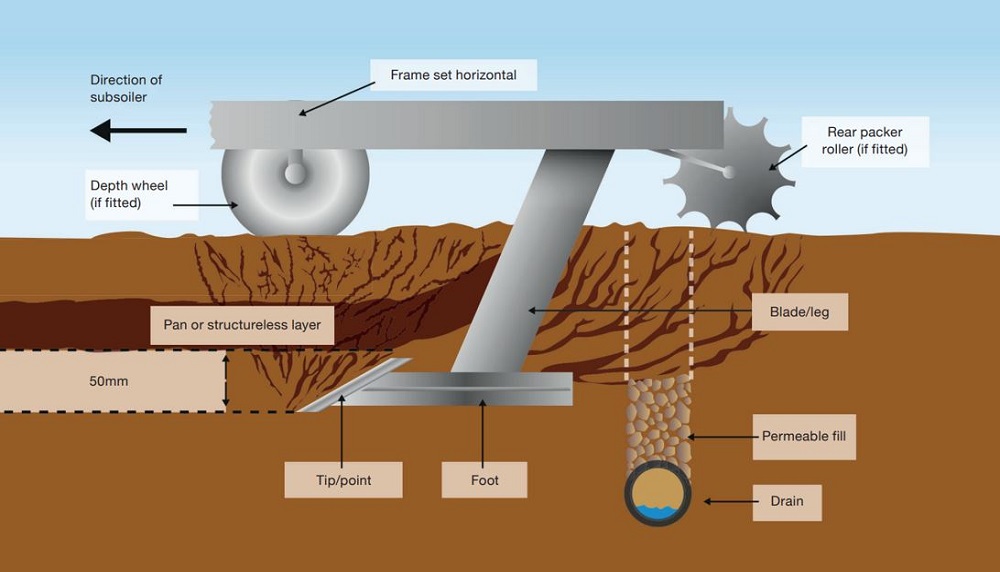- Home
- Knowledge library
- Field drainage: The importance of soil health
Field drainage: The importance of soil health
If soil examination identifies compacted layers that impede water movement, take remedial action to remove them before considering drainage investment.
Good soil management
To minimise soil damage, reduce:
- Field trafficking
- Machinery weight
- Tyre pressures
- Livestock poaching
- Overworking of the seedbed
Also consider:
- Using low-pressure tyres, minimum tillage, controlled traffic farming and fixed wheelings
- Avoiding turnout in poor soil conditions
- Placement of livestock feeders and drinkers, and livestock tracks
Read more about soil structure
Subsoil and topsoil loosening
When soils are wet, they are easily damaged by cultivation, machinery traffic and livestock trampling.
If the soil structure has been damaged, subsoil or topsoil loosening (normally referred to as ‘subsoiling’ and ‘sward lifting’ respectively) in suitable conditions can help restore it and improve subsoil permeability.
Subsoiler operation
 AHDB
AHDB
Equipment options
Winged subsoilers shatter the soil much more effectively than conventional subsoilers. Although they require higher draught forces, they can disturb a volume of soil that is two to three times greater than a conventional subsoiler.
The use of leading tines can increase the volume of soil disturbed without increasing the draught, but they are not suitable for grassland as they cause considerable surface disturbance.
Topsoil looseners (sward lifters) for grassland incorporate a leading disc, a vertical or forward-inclined leg, and a tine leg with a packer roller behind to minimise sward tear and surface disturbance.
Slit aerators can also be used in grassland fields but should only target the top ten centimetres. Although they can increase infiltration rates, good conditions are needed below the target area or they may just move water more quickly towards a drainage problem.
Learn how to assess soil moisture content in the field
Suitable conditions
Carry out topsoil loosening and subsoiling when the soil at working and loosening depth is in a ‘dry’ and friable condition, so that it will shatter rather than smear.
Examine soils early in the operation to ensure effective shattering is occurring.
For arable subsoiling, both the soil surface and the compacted layer should be relatively dry to avoid soil structural damage.
In grassland, use a sward lifter, ideally when the soil surface is slightly moist. This allows disc and tine leg entry, while avoiding excessive sward tear. The lower topsoil should be moist to dry, to enable ‘lift’ and loosening.
Depth
It is best practice to use a depth wheel or rear packer roller to maintain a constant tine depth.
Aim for tines to be about 25–50 mm below the base of the compacted layer, up to a maximum depth of about 450 mm below ground level.
Maximum depth may be limited by shallow field drains, rock, or the critical depth of the tine (related to tine width and soil conditions).
Normal drain depth is around 700 mm below the soil surface.
For subsoiling, the depth to which the soil is loosened must be just greater than the depth down to the top of the permeable backfill. This will connect the fissures and allow water to move to the permeable fill over the drains.
Tine spacing
- Conventional subsoiler − up to 1.5 times the tine depth
- Winged subsoiler − up to 2 times the tine depth
- With leading shallow tines − up to 2.5 times the tine depth
After a trial run, dig down and examine the effect.
Spacing can be adjusted, where possible, to achieve the desired degree of soil disturbance.
Avoid re-compaction
Recently loosened soils are sensitive to compaction, so avoid running over land that has been subsoiled.
In grassland, avoid grazing after autumn loosening and cut rather than graze in the first spring after treatment.
Back to the field drainage home page
Further information
Find out more with our soil management information
Read the Cranfield University guide to better soil structure
Topics:
Sectors:
Tags:

